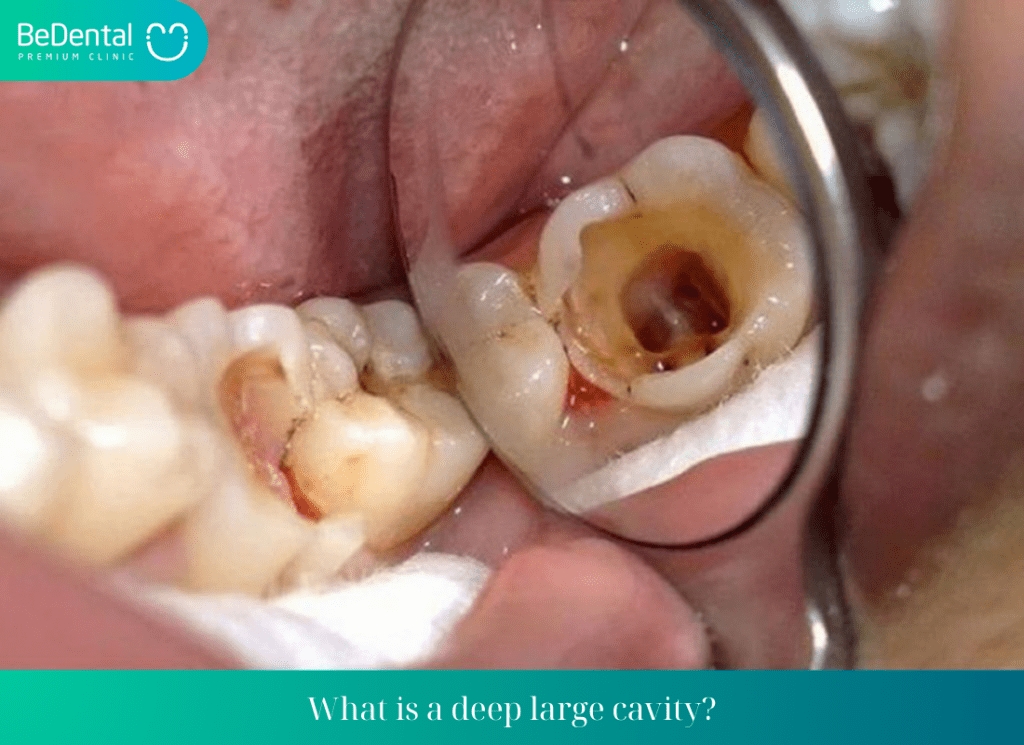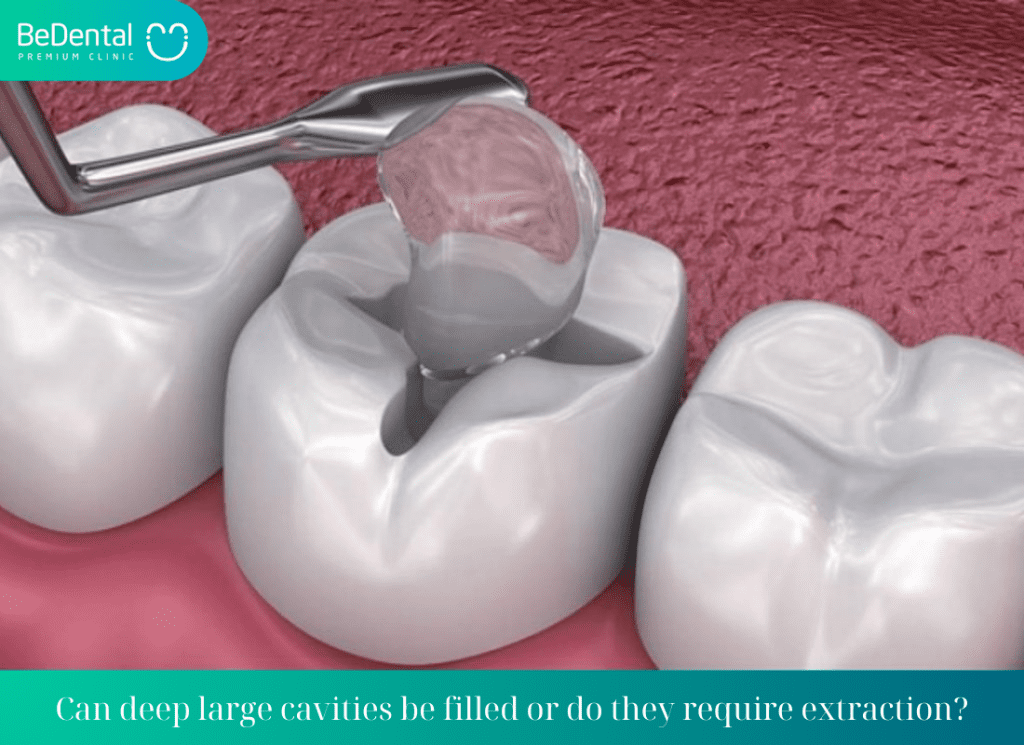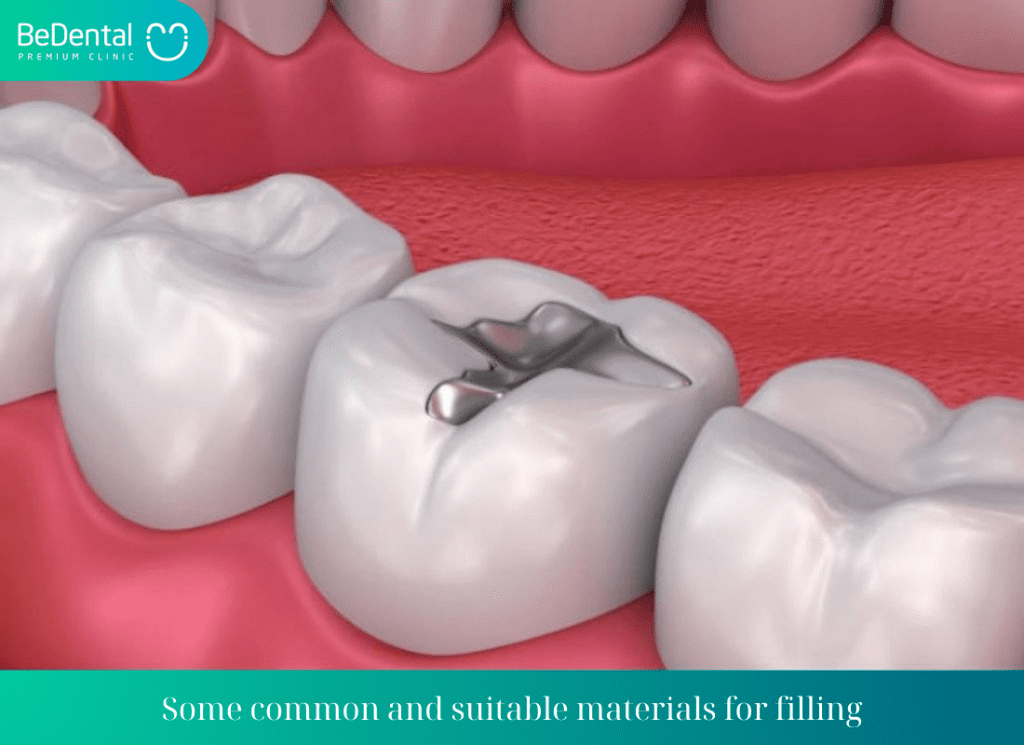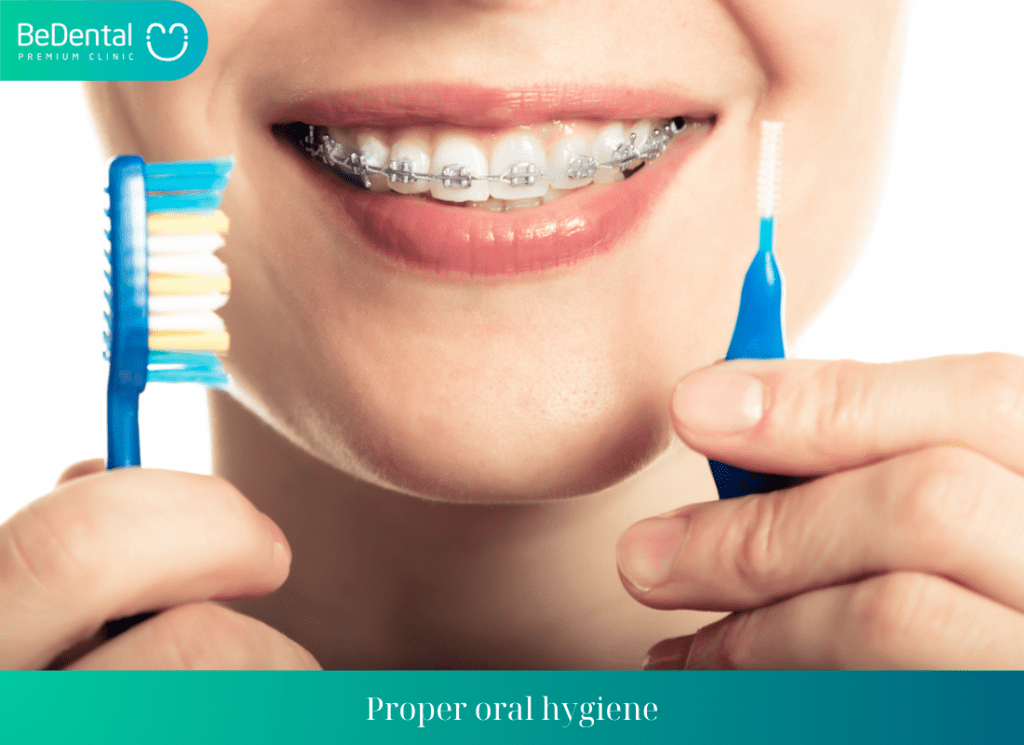Many people with cavities often wonder if deep, large cavities can be filled. What is a deep cavity? What are the causes of deep large cavities? How much does it cost to fill a large cavity? Is filling deep cavities really effective? We will find answers at Bedental Dental Clinic.
What is a deep large cavity?
What is a deep cavity? A deep, large cavity occurs when a tooth has been decayed for an extended period without timely treatment. As a result, harmful bacteria continue to thrive, eroding and creating large holes in the tooth. In more severe cases, the decay may extend deep into the pulp.

Usually, deep large cavities tend to appear in the molar teeth. Because these teeth are situated deep inside the jaw, maintaining cleanliness can be quite challenging. Due to the obscured location, when deep cavities form, they may not be visible to the naked eye. Typically, individuals only become aware when the area of the mouth starts to ache. Deep large cavities not only affect the aesthetics of the mouth but also pose other risks for oral health:
See more: What is tooth filling?
- Cause toothaches and damage to the nerve.
- Prolonged inflammation and infection of the tooth pulp, leading to erosion and pulp death.
- Infection in the oral cavity.
- Increased likelihood of teeth being prone to breakage, cracking, or even falling out.
What are the causes of deep large cavities?
The causes of deep large cavities are often attributed to the following three factors:
- Harmful bacteria developing on the teeth.
- When eating, if oral hygiene is not maintained properly, food debris can stick to the teeth, creating a favorable environment for bacterial growth.
- Additionally, food residue left on the teeth for an extended period can lead to discoloration and heightening of the teeth, gradually forming deep cavities.
Overall, the cause of deep large cavities is a lack of awareness in oral care, improper and irregular brushing habits. Moreover, an unhealthy diet also contributes to the development of deep large cavities.
Symptoms of deep large cavities
Symptoms of deep large cavities can often be visually identified. When the enamel and dentin are damaged, using a dental pick, one can easily observe the deep cavities.
See more: How much does filling a cavity cost?
When consuming cold, spicy, or hot foods, the teeth may become sensitive and painful.
Deep cavities containing bacteria and food debris can cause bad breath. Over time, this may lead to unpleasant odors in the mouth.
Can deep large cavities be filled or do they require extraction?
Usually, when a tooth has minor decay, the dentist will fill it to restore and protect the tooth. Dental filling techniques are used to fill deep cavities with dental materials to prevent bacteria and food from infiltrating and causing infection.
This is a common method in treating cavities, with reasonable costs and typically applied in cases of minor decay. However, for deep large cavities, dental fillings may not be the optimal solution. Although they can still be performed, the durability may not be as high.

With deep large cavities, the area that needs filling is extensive, reducing the adhesive properties of the filling material. When subjected to the forces of chewing regularly over a long period, the filling material is prone to dislodging. Therefore, dentists often recommend customers to consider options such as dental crowns, veneers, or the use of Inlay/Onlay filling techniques for treatment.
See more: What are the cost of braces?
Some common and suitable materials for filling deep large cavities
Although dentists do not prioritize filling deep large cavities, there are still cases where customers prefer this treatment method. Below are some of the common and most suitable materials for filling large deep cavities:
Amalgam
Amalgam is a dental filling material composed of a mixture of mercury, tin, silver, etc. It is a traditional filling material known for its high durability and longevity. Amalgam fillings used to be very popular in the past.

Therefore, for deep large cavities, the durability and hardness of Amalgam ensure better performance and longevity. However, the drawback of Amalgam is its metallic color, which differs significantly from the natural tooth color. Therefore, Amalgam is usually only suitable for molars.
Composite
Composite dental fillings are the most widely used method today, thanks to advancements compared to Amalgam materials. With a translucent white color similar to natural teeth, composite fillings make it difficult to distinguish the filled tooth from the surrounding teeth.
See more: What is orthodontic treatment? Should you get braces?
Furthermore, composite has very high compatibility and does not harm the teeth or cause negative reactions in the body. However, for deep large cavities, composite is only suitable as a temporary solution and not ideal for long-term use. The durability of composite fillings is not high, so if used on a large area, they can quickly deteriorate after a short period.
Porcelain Inlay/Onlay – the perfect solution for filling deep large cavities
Filling teeth with porcelain Inlay/Onlay is an excellent current solution for addressing large deep cavities. These custom-made fillings are crafted from high-quality porcelain material, ensuring excellent durability and adhesion.
Unlike traditional filling methods, porcelain Inlay/Onlay fillings are individually made in a laboratory based on the actual shape of the tooth.
The durability and adhesion of these fillings are highly rated by experts.
Steps for filling deep large cavities
The steps for filling deep large cavities are as follows:
Step 1: Dental examination and consultation with the dentist
See more: Do porcelain crowns cause gum recession
The dentist will examine the deep large cavity to determine its size and advise on the appropriate filling material.
Step 2: Oral hygiene

This step is crucial to prevent infection. You need to clean your mouth thoroughly, rinse with mouthwash to remove food residue.
Step 3: Numbing the area for filling
The dentist will numb the area requiring filling. Then, the deep cavity will be cleaned using special tools to remove excess food particles and shape the filling cavity.
Step 4: Filling the tooth
The dentist will use the chosen filling material to fill the deep cavity in the tooth. The filling material initially is in a liquid state and will then harden using a laser.
See more: How much does dental filling cost?
Step 5: Adjusting and shaping the aesthetic filling
After filling the deep cavity, the dentist will adjust and remove any excess filling material. They will shape the filling to make it aesthetically pleasing, smooth, and comfortable.
How much does it cost to fill a large cavity?
How much does it cost to fill a large cavity? The price of filling deep large cavities is a concern for many people nowadays. In quality dental clinics, the cost of filling deep large cavities ranges from 300,000 to 1,000,000 VND per tooth.

To ensure effectiveness and safety for your health, you should only choose to fill deep large cavities at reputable dental clinics with highly skilled and experienced dentists.
Some solutions to prevent deep large cavities
To prevent deep large cavities, here are some solutions:
Preventing the development of tooth decay
To prevent the occurrence of deep large cavities due to untreated tooth decay, pay attention to the symptoms of tooth decay and seek treatment promptly when detected.
See more: What is the appropriate age for braces?
Proper oral hygiene
Brush your teeth at least twice a day with a soft-bristled toothbrush and use fluoride toothpaste. To effectively remove plaque, you can also use dental floss or a water flosser.
Rinse with saltwater or mouthwash solution
Saltwater has been proven to have effective antibacterial properties, eliminating harmful bacteria for your teeth. You can also use mouthwash to clean plaque more effectively.
Regular dental check-ups
Visiting the dentist for regular check-ups 1-2 times a year helps protect your overall oral health. Don’t wait until you have a tooth decay issue to see the dentist, as addressing it later will take more time and money.
Scaling every 6 months
Plaque will accumulate over time. Brushing your teeth twice a day is not enough to completely remove plaque. Therefore, scaling every 6 months helps remove plaque and maintain oral health.
When you notice signs of tooth decay, visit the dentist for an early diagnosis and treatment. Don’t let the cavity spread too large, as this will make the treatment process more costly and time-consuming.
See more: Do i need braces for mild overbite?
Therefore, to know how much it costs to fill deep large cavities? Whether filling deep large cavities can be done or not, visit reputable dental clinics to have the dentist examine and recommend suitable treatment.
Conclusion
Tư vấn chuyên môn bài viết:
BÁC SĨ DƯƠNG THỊ THÙY NGA





